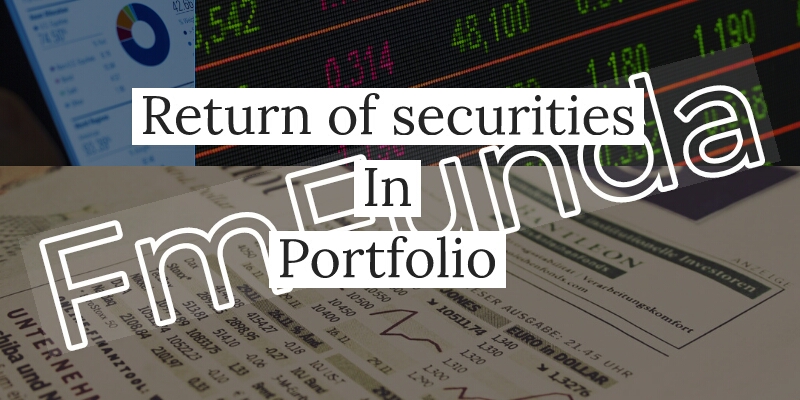The portfolio expected return is a straightforward weighted average of returns on the individual securities; the portfolio standard deviation is not the weighted average of individual security standard deviations.
Let's understand correlation between securities in Portfolio:
Suppose we have two stocks A and B in our portfolio. During a given period the return of A increases say by 1% while that of B increases by 0.5% in the same period.This means that both are moving positively in the direction of increasing returns. This is described as positive correlation. However the quantum of increase is not the same in both the cases.
Hence this is imperfect but positive correlation. In case the quantum of increase is 1% in both the cases, then the correlation is said to be positive and perfect correlation.
If the returns move in the opposite direction, say one increasing and the other decreasing, then the correlation is negative. Still the relationship could be perfect in the sense that the quantum of increase in return say in the case of A is the same in the case of B but in the opposite direction. This means that while stock A has increased its return, stock B has lost its return by the same percent.
Let us try to put these in the form of equations.
“Δ” represents the increase in return and (“Δ”) (within brackets-indicate that the return is decreasing).
Keeping these in mind let us attempt the following:
Δ of stock A = 1% for a given period = Δ of stock B = perfect and positive correlation
Δ of stock A = 1% for a given period; Δ of stock B = greater than or less than 1% but the return has increased and not decreased = positive but imperfect correlation
Δ of stock A = 1% for a given period; (“Δ”) of stock B = 1%. Then stock A and stock B are said to have perfect but negative correlation.
Δ of stock A = 1% for a given period; (“Δ”) of stock B less than or more than 1%. Then stock A and stock B are said to have imperfect and negative correlation.
We have consciously omitted the fifth possibility of both the stocks A and B losing to the same percent during a given period.
Any portfolio would avoid such stocks unless the future is going to be completely different in which case the past is not the basis on which stock selection is being made.
We have also tried to present these concepts in as simple a manner as possible. You are advised to go through these repeatedly to grasp the essence of the underlying concept in correlation between one stock and another. This is required because the concept of correlation is the fundamental based on which the selection of stocks for a portfolio is done. You will appreciate that positive correlation between two stocks would mean increased risk especially if the relationship is perfect. Negative correlation stocks are not desirable.
What is then left is positive but imperfect correlation. The risk-averse investors would invariably choose such stocks as show positive relationship between them (or among them in view of the number of stocks in a portfolio being more than 2, which is usually the case) but not perfect relationship. Then only the risk in a portfolio is reduced. For a given period, same degree of movement in return on different stocks in the same direction only increases the risk in a portfolio.
Now going back to the standard deviation of a portfolio, we will appreciate that it is not merely the weighted average of the standard deviation numbers for each stock in the portfolio. Suppose there are five stocks in a portfolio. We can appreciate that there are quite a few possible combinations of these five stocks depending upon the proportion of investment in each of them; for each combination, the weighted average of the standard deviation numbers has to be etermined first and then the ultimate average standard deviation should be found out for all possible combinations.
This involves a very complicated calculation and hence not presented here. However before we end this topic it should be mentioned that the complicated calculation is worth the time invested in, as the ultimate result is reduction in the total risk of the portfolio. This is the very objective of a portfolio.
Kinds of risk - diversifiable and non-diversifiable
Diversifiable or non-systemic risks
A portfolio aims at minimising the risk and optimising the returns. Any portfolio chooses the constituent stocks based on certain parameters and one of the important parameters is the correlation among the various stocks. A portfolio diversifies the risk by choosing stocks of:
- Different sectors
- Different units in the same sector
- Different aturities and different instruments including money market.
Let's explain this through examples.
Your portfolio could contain stocks of Cement, Textiles, Software and Pharmaceuticals. This is called sector diversification. You will choose such sectors as are not having perfect correlation.
Your portfolio could contain stocks of ACC, Larsen & Toubro and Dalmia Cements. This is called unit diversification in the same sector. You will choose again such units as are not having perfect correlation.
Your portfolio could contain one-year investment (bond or debenture), more than one-year investment and long-term investment too. This is called maturity diversification. Here the relationship will rarely be perfect.
Your portfolio could contain investment into equity shares, debt instruments and money market instruments. This is called instruments diversification. Here too the relationship will not be perfect as these relate to different segments of the Financial Markets.
All the above are examples of diversifiable risks. One can use detailed analytical study of the past trends and knowledge about the various sectors and specific units for true diversification of stocks in a portfolio. Such diversifiable risks are often referred to as non-systemic risks or specific risks as such risks are not thrown in by the system.
Non-diversifiable or systemic risks
Suppose we do all the above and arrive at a very good portfolio. The US and their allies decide to bomb IRAQ. All hell breaks loose. All the markets internationally are nervous.
Can you and I do something about it besides feeling helpless about the whole thing? Such kind of risks could be specific to a country or economy or universal in its impact.
The universality of market risks depends upon the degree of integration of different countries into the global system. The more they are integrated the higher will be the degree of uniformity of impact due to US bombing IRAQ. We cannot diversify this kind of risk at least within a country or system, although global investors are in a better position to diversify the country specific risk by pulling out of the country and reinvesting the amount in less risky markets.
Typical example of a market risk in India Sensex crashing from 6000 odd points in early 2000 to less than 3000 points in 2002. The markets becoming nervous on news of Indo-Pak war is another example.
Total risk of a portfolio = market risk of the portfolio + specific risk of the portfolio










0 comments:
Post a Comment